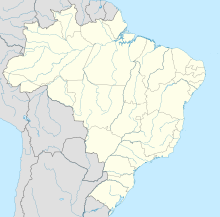Serra Pelada

The former pit of Serra Pelada now forms a lake
|
|
| Location | |
|---|---|
| State | Pará |
| Country | Brazil |
| Coordinates | 5°56′39″S 49°39′53″W / 5.944273°S 49.66472°WCoordinates: 5°56′39″S 49°39′53″W / 5.944273°S 49.66472°W |
| Production | |
| Products | Gold |
| Production | Official records: 44.5 tons Black market estimate: 360 t |
| History | |
| Opened | 1980 |
| Closed | 1986 |
Serra Pelada (English: "Naked Mountain") was a large gold mine in Brazil 430 kilometres (270 mi) south of the mouth of the Amazon River. The mine was made famous by the images taken by Alfredo Jaar and later by Sebastião Salgado showing an anthill of workers moving vast amounts of ore by hand. Because of the chaotic nature of the operation estimating the number of miners was difficult, but at least 100,000 people were thought to be present, making it one of the largest mines in the world. Today the Serra Pelada mine is abandoned and the giant open pit that was created by hand has filled with water, creating a small polluted lake.
In January 1979 Farmer Genésio Ferreira da Silva hired a geologist to investigate whether gold he found on his property was part of a larger deposit. A local child swimming on the banks of a local river found a 6 grams (0.21 oz) nugget of gold. Soon word leaked out that indeed da Silva was sitting upon one of the largest deposits in the world. By the end of the week a gold rush had started with thousands of people descending on the farm to mine. Five weeks later, there were 10 000 on Ferreira's property and another 12 000 nearby. Huge nuggets were quickly discovered, the biggest weighing nearly 6.8 kilograms (15 lb), $108,000 at the 1980 market price ( now $ 313,924 in 2017).
At first the only way to get to the remote site was by plane or foot. Miners would often pay exorbitant prices to have taxis drive them from the nearest town to the end of a dirt track; from there, they would walk the remaining distance—some 15 kilometres (9.3 mi) to the site. The growing town, since it could only be made of material that was carried in by hand, was a collection of haphazard shacks and tents. Each miner had a claim 2 metres (6.6 ft) by 3 metres (9.8 ft). By May 1980 there were 4 000 such claims.
Early in the history of the mine, the Brazilian military took over operations to prevent exploitation of the workers and conflict between miners and owners. Before the military takeover basic goods were sold for hugely inflated prices by the mine owners; water cost $3 a litre ($ 8.72 in 2017). The infamous Sebastião Rodrigues de Moura (known more by his nickname Coronel Curió) managed the mine for a brief period.
While the military government banned women and alcohol at the actual mine, the nearby town became a town of "stores and whores". Thousands of underage girls prostituted themselves for gold flakes while around 60–80 unsolved murders occurred in the town every month.
...
Wikipedia

